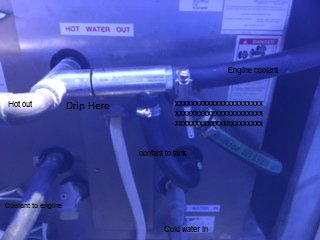meridian
Guru
There is a cylindrical metal T fitting on the output side of my friends hot water tank. The hot water flows directly through the T. The bottom of the T is attached to another cylinder that has the engine coolant going from the engine and into the tank. Antifreeze is dripping from the slot between the cylinders.
I think this may be a thermostat valve that will stop engine coolant from circulating through the tank if the output hot water is too hot. I expect that the engine coolant can get much hotter than the pressure relief valve.
Any ideas on this? There are no markings that I can see.
I think this may be a thermostat valve that will stop engine coolant from circulating through the tank if the output hot water is too hot. I expect that the engine coolant can get much hotter than the pressure relief valve.
Any ideas on this? There are no markings that I can see.

